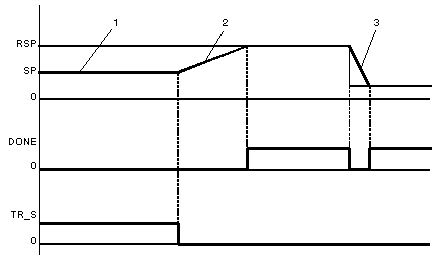If the value given on input (RSP) exceeds the current value of the SP_output, the function block increases the value of the output with the velocity inc_rate by as much as is necessary for the SP value to reach the RSP value. If the inc_rate is zero, the ramp function will not be executed and the SP is identical to the RSP.
If the value given at an input falls below the current value of SP, the function block lowers the value of SP with the velocity dec_rate. If the dec_rate is zero, the ramp function will not be executed and the SP is identical to the RSP.
If the value of RSP changes whilst the ramp is being generated, the function block immediately attempts to reach this new target value. The ramp function, which is running simultaneously, either continues or changes its direction.
The tracking operation (TR_S = 1) allows for an initial value to be assigned to the SP output. They are as follows:
|
Step
|
Action
|
|
1
|
TR_I set to the desired initial value.
|
|
2
|
When TR_S is set to 1, the TR_I input will continue to be executed at SP.
Note: In the tracking mode (TR_S = 1) the DONE output remains permanently at zero.
|
|
3
|
If TR_S is set to 0, the function block resumes normal operation: The SP constantly approaches the RSP, where the value describes a ramp.
|
The DONE output goes above 1, if a ramp function has just been completed. It will be reset to zero, when a new ramp begins or when the function block is switched to tracking mode.
Timing diagram for RAMP block
1
Initialization: SP = TR_I
2
Increasing ramp = inc_rate
3
Decreasing ramp = dec_rate 